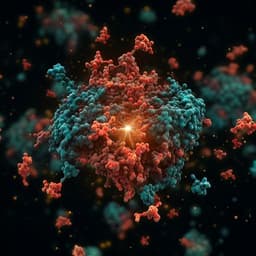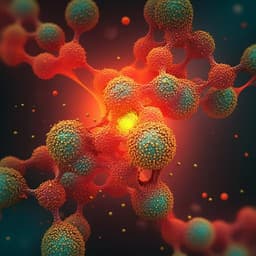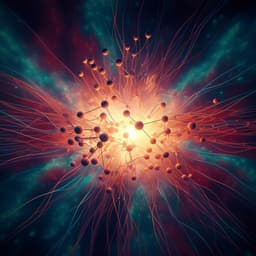
Physics
Machine learning assisted quantum super-resolution microscopy
Z. A. Kudyshev, D. Sychev, et al.
Discover how a team of researchers, including Zhaxylyk A. Kudyshev and Demid Sychev, has developed a groundbreaking machine learning-assisted approach for rapid antibunching super-resolution imaging. This innovative method achieves a remarkable 12-times speedup, paving the way for scalable quantum super-resolution imaging devices compatible with various quantum emitters.
~3 min • Beginner • English
Introduction
Conventional far-field microscopy is constrained by the diffraction (Rayleigh/Abbe) limit to approximately half the illumination wavelength. Classical super-resolution microscopy (SRM) methods such as stimulated emission depletion, structured illumination, photoactivated localization microscopy, and stochastic optical reconstruction microscopy surpass this limit by relaxing assumptions of homogenous illumination, linear, stationary, and classical light-matter response. A complementary route exploits the quantum nature of light. Some proposals use engineered illumination with squeezed or generalized quantum states, which demand complex, efficient quantum sources. An alternative leverages the nonclassical emission statistics of the sample itself. Quantum emitters can exhibit sub-Poissonian photon statistics detectable via n-th order photon autocorrelation functions at zero time delay, g^(n)(0), enabling a √n reduction of the effective point spread function. Antibunching-based SRM, especially when combined with image scanning microscopy, can achieve up to fourfold resolution enhancements with modest hardware overhead. However, practical adoption is hindered by the long acquisition times needed for reliable estimation of g^(n)(0), with time cost growing rapidly with n due to the need for sufficient multiphoton coincidence events. For g^(2)(0), accurate estimation from time-resolved Hanbury-Brown–Twiss (HBT) histograms typically requires per-pixel integration times on the order of minutes for emitters like NV centers. To address this bottleneck, the authors propose a machine-learning (ML)–assisted approach using a convolutional neural network (CNN) to regress g^(2)(0) from sparse HBT histograms, enabling significant speed-ups while retaining accuracy.
Literature Review
The paper situates its contribution within two bodies of prior work. Classical SRM methods (e.g., STED, SIM, PALM, STORM) have achieved sub-diffraction imaging by exploiting nonlinear responses, structured illumination, or stochastic localization. Quantum-inspired approaches have established theoretical and experimental foundations for surpassing diffraction limits using quantum correlations and optimal measurements, including centroid measurements and quantum correlation microscopy. Antibunching-based SRM leverages the intrinsic nonclassical photon statistics of quantum emitters; prior work has demonstrated resolution gains up to fourfold when integrating second-order correlations with image scanning microscopy. Machine learning has recently been used to classify quantum emitters based on whether g^(2)(0) is below a threshold from sparse autocorrelation measurements. Building on these, the present work advances from ML-based classification to precise regression of g^(2)(0) from short-duration HBT histograms to accelerate antibunching SRM.
Methodology
Antibunching SRM principle: Measuring g^(n)(0) of nonclassical emission from point sources enables a √n shrinkage of the effective point spread function. Practically, g^(2)(0) is measured via HBT interferometry: emission is split by a beam splitter to two single-photon detectors; a correlation board records time delays between coincident clicks, producing a histogram used to estimate g^(2)(τ) and infer g^(2)(0). Conventional estimation uses Levenberg–Marquardt (L-M) fitting to a multi-level emitter model but requires long acquisition times for accurate fits.
Experimental setup and sample: Single nitrogen-vacancy (NV) centers in nanodiamonds (≈20 nm) dispersed on a cleaned glass coverslip were used as emitters. Optical characterization employed a custom scanning confocal microscope (Nikon Ti-U base) with a 100 µm pinhole and an oil-immersion objective (NA 1.49). The sample was scanned with a P-561 piezo stage (sub-10 nm resolution; E-712 controller) over a 775 × 775 nm^2 field (32 × 32 pixels). Continuous-wave 532 nm excitation (≈1 mW at the objective entrance, above NV saturation) was used. Emission was filtered by a 550 nm long-pass dichroic mirror and 550 nm long-pass filter. Two avalanche photodiodes (≈30 ps time resolution, 35% QE at 650 nm) fed a time-correlated “start–stop” acquisition card (SPC-150, 4 ps internal jitter). HBT histograms covered 500 ns, binned into 215 equal time bins. Typical in-focus single-photon count rates per detector ranged from about 10^? to 10 counts/s (order-of-magnitude single-photon rates), with lifetimes 10–100 ns; partial defocus reduced counts during scans.
CNN regression model: A 1D CNN regresses g^(2)(0) from sparse histograms. Architecture: input layer with 215 nodes (histogram bins); three 1D convolutional layers (each 260 filters, kernel size 4), followed by max pooling and dropout; then three fully connected layers; a single scalar output predicts g^(2)(0). The total number of two-photon detection events, N_events, is provided as an auxiliary input concatenated to the learned feature vector and used as a regularizer. To bias predictions in dark regions, the network implicitly learns to output g^(2)(0) ≈ 1 when N_events < 4, whereas typical near-emitter histograms had N_events ≈ 65 over 5–10 s.
Training data and augmentation: HBT measurements were collected on 40 randomly dispersed NV-containing nanodiamonds. For each emitter, many 1 s histograms were acquired until their sum yielded a high-SNR “full” histogram enabling accurate ground-truth g^(2)(0) via L-M fitting to a three-level emitter model (zero-delay bin position assumed known). The 1 s sparse histograms were labeled with this ground truth. Data augmentation formed all combinations of 1–10 histograms (bin-wise summation) to emulate 1–10 s acquisitions, assuming stationarity over times >1 s. The resulting dataset comprised 9,416 sparse histograms, with g^(2)(0) spanning 0.1–0.884 and 1 s histogram total counts ranging from 1.2 to 61. Training used Keras (adamax optimizer), 100 epochs, mean absolute percentage error (MAPE) loss; 80%/20% split for training versus validation/testing.
Benchmarking and imaging protocol: During imaging, each pixel’s HBT histogram was accumulated in 1 s increments up to a target total (e.g., 5–7 s). Two pipelines were compared: (1) conventional L-M fitting on sparse histograms to estimate per-pixel g^(2)(x,y,0), then compute the antibunching SRM image; (2) pre-trained CNN regression to estimate g^(2)(x,y,0) rapidly from sparse data, then compute the SRM image. For resolution assessment, the photoluminescence (PL) image PSF was modeled as Gaussian with FWHM ≈ 300–310 nm based on measured cross-sections and Gaussian fits. Super-resolved images were compared via cross-sections and Gaussian FWHM estimates. Additional demonstrations included resolving two closely spaced emitters (~600 nm apart) and Monte Carlo simulations for two and three emitters (Supplementary).
Key Findings
- The ML-assisted approach provides a 12× speed-up over conventional L-M fitting for retrieving g^(2)(0) in scanning SRM of NV centers, reducing per-pixel acquisition from ≥1 min to as little as 5–10 s while maintaining accuracy.
- CNN regression performance on 5 s histograms: MAPE ≈ 5%, r^2 ≈ 93%, RMSE ≈ 0.0018. By contrast, L-M fitting on the same sparse data yields MAPE ≈ 32%, r^2 ≈ 70%, RMSE ≈ 0.215.
- Robustness to reduced acquisition: CNN MAPE 3.92% (6 s) and 3.58% (7 s), outperforming L-M fitting (≈30% at 6 s; 27% at 7 s).
- Resolution enhancement for a single emitter: PL cross-section FWHM ≈ 310 nm (diffraction-limited). CNN-based antibunching SRM yields FWHM ≈ 219 nm, consistent with the expected √2 improvement (σ_CNN = σ/√2).
- Two-emitter case (~600 nm separation): PL lobes FWHM ≈ 465 nm; CNN-based SRM narrows to FWHM ≈ 330 nm (≈√2 improvement), improving separability.
- Practical CNN inputs reflect photon statistics: dark pixels with N_events < 4 are driven to g^(2)(0) ≈ 1; near-emitter regions had N_events ≈ 65 in 5–10 s windows, supporting accurate regression.
Discussion
By learning correlations between sparse HBT histogram features and ground-truth g^(2)(0), the CNN enables accurate, rapid estimation of g^(2)(0) maps, directly addressing the primary bottleneck of antibunching SRM: lengthy acquisition times for reliable autocorrelation estimation. The demonstrated √2 resolution gain from second-order correlations and the ability to resolve closely spaced emitters confirm that ML-assisted antibunching SRM can deliver super-resolved images with substantially reduced measurement burden. The approach is compatible with standard confocal scanning workflows commonly used for quantum emitters, requiring only modest hardware and leveraging software-side acceleration. Conceptually, the method can be extended to higher-order autocorrelations to achieve further resolution gains; however, the practical utility will depend on managing signal-to-noise and photon budget constraints as correlation order and emitter density increase. Overall, the results advance scalable, practical quantum super-resolution imaging and suggest broader applicability across platforms where sub-Poissonian emission can be measured.
Conclusion
The study introduces a CNN-based regression framework that predicts g^(2)(0) from sparse HBT histograms, enabling machine learning–assisted antibunching super-resolution microscopy with up to 12× faster acquisition than conventional fitting while preserving accuracy and delivering the expected √2 resolution enhancement. Experimental validation on single NV centers and closely spaced emitters, along with robustness across 5–7 s acquisitions, highlights practicality for quantum emitter imaging. Future research directions include extending the ML regression to higher-order autocorrelation functions for greater resolution gains, improving performance in dense-emitter scenarios with low SNR, and exploring generalization to diverse quantum emitters and excitation modalities.
Limitations
- Extension to higher-order autocorrelation measurements is challenged by reduced signal-to-noise ratio, especially at higher marker densities; it remains uncertain whether ML can fully overcome these issues.
- Accurate L-M ground-truth labeling assumes the zero-delay time bin is known; misassignment could bias training labels and predictions.
- Performance and required acquisition times depend on emitter properties (quantum purity, lifetime, emission rate); results were demonstrated on NV centers and may require adaptation for other systems.
- The CNN biases dark pixels (very low N_events) toward g^(2)(0) ≈ 1; in scenarios with background correlations or complex backgrounds, this heuristic could introduce errors.
- Code and datasets are available upon request rather than fully open, which may limit immediate reproducibility by third parties.
Related Publications
Explore these studies to deepen your understanding of the subject.







